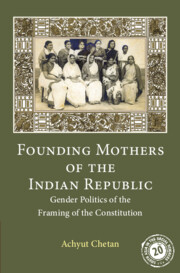Book contents
- Frontmatter
- Dedication
- Contents
- List of Images
- Preface
- Acknowledgements
- List of Abbreviations
- Introduction: Towards a Feminist Reading of the Making of the Constitution
- 1 In the Shadow of the Founding Fathers
- 2 In Search of the Missing Mothers
- 3 Women’s Moral Imaginary and Constitutional Politics: 1927–1946
- 4 Patterns of Participation: Women Members in the Constituent Assembly
- 5 Writing the Rights: Inscribing Constitutional Morality
- 6 Reformulating the ‘Woman Question’: Challenging Customs and Traditions
- 7 After the Framing
- Conclusion: Remembering the Founding Mothers
- Appendix: Texts and Contexts of the Framing – A Timeline
- Bibliography
- Index
7 - After the Framing
Published online by Cambridge University Press: 27 September 2022
- Frontmatter
- Dedication
- Contents
- List of Images
- Preface
- Acknowledgements
- List of Abbreviations
- Introduction: Towards a Feminist Reading of the Making of the Constitution
- 1 In the Shadow of the Founding Fathers
- 2 In Search of the Missing Mothers
- 3 Women’s Moral Imaginary and Constitutional Politics: 1927–1946
- 4 Patterns of Participation: Women Members in the Constituent Assembly
- 5 Writing the Rights: Inscribing Constitutional Morality
- 6 Reformulating the ‘Woman Question’: Challenging Customs and Traditions
- 7 After the Framing
- Conclusion: Remembering the Founding Mothers
- Appendix: Texts and Contexts of the Framing – A Timeline
- Bibliography
- Index
Summary
I hope that some of us will live to see that the Constitution becomes a real stronghold for human rights and it will be worked towards establishing a real democracy, so that there will be happiness and prosperity for everyone in India.
—Ammu Swaminathan, Constituent Assembly Debates, 24 November 1949On Thursday, 17 November 1949, B. R. Ambedkar moved the last resolution of the Constituent Assembly. He asked ‘that the Constitution as settled by the Assembly be passed’. The terms of reference had changed. It was no more the first or the second draft that the Assembly was asked to consider. There were no amendments left to be moved. It was the Constitution itself, as it was to be signed by all the founding mothers and fathers, which he was moving before the house. The President, Dr Rajendra Prasad, thought a general discussion about the Constitution would be a fitting end to the work of the Assembly and must take place before the Assembly could be adjourned sine die. The discussions began on that day and continued for 10 days, ending with Ambedkar's valedictory speech on 26 November 1949 which was cheered by ‘a resounding applause by the entire house for more than three minutes’.
Many members spoke on the Constitution, about their experience of participating in these great moments of the framing, and the hopes they had of the future. Five women members, namely, Renuka Ray, Aizaz Rasul, Purnima Banerji, Hansa Mehta, and G. Durgabai participated in these general debates. These readings can be considered the first act of constitutional interpretation by these women. The Constitution emerged in their reading as a living document, which needs to be read as a whole, and not just as list of governmental purposes and processes.
First, the Constitution became a source of a national identity based on the principles and aspirations that would bind the citizens. The will of the people was the will of a people who were tied to each other not by inherited, common cultural and social capital, but by shared principles and aspirations. We must not ‘look backwards and dissect this Constitution’, said Durgabai, because as an expression of the will of the people, it was a forward-looking document.
- Type
- Chapter
- Information
- Founding Mothers of the Indian RepublicGender Politics of the Framing of the Constitution, pp. 249 - 274Publisher: Cambridge University PressPrint publication year: 2023

